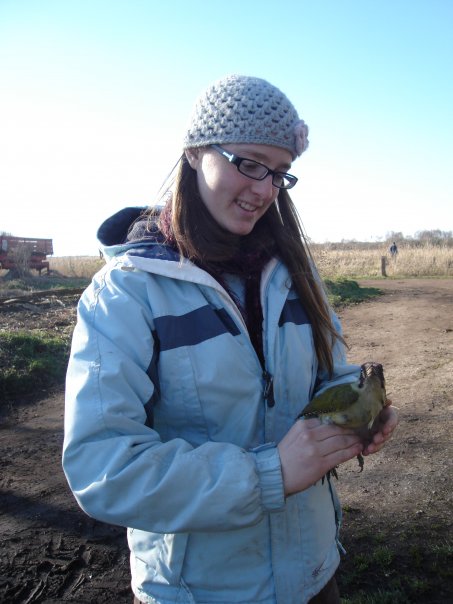Last week I'd decided too much time had past since I last ringed at Wicken Fen. I hadnt seen a warbler in the hand for about 8 months! So, hoping desperately I could still remember everything about warblers, I emailed Chris to ask if I could join them and get a lift.
The standard sites sessions at Wicken run from 12 noon one day to 12 noon the next, and seeing a chance to get a spot of revision in (half an hour breaks between net rounds really are effective for that), I decided to go for the whole weekend. A nice break from the monotony of Cambridge
All was going well until, in the middle of a page about deer eating shearwater chicks (!) to obtain calcium from their bones, Chris walked in with a bird. It was brown. It was not a sparrow, or a dunnock, or a wren, or anything that you expect to be brown. It didnt look like I remembered a garden warbler to look, but seeing as I didnt have much more of a clue, that was my first guess. Chris shook his head. I look more closely at the bird. I cant think what on earth it could be - it had a faint eye stripe, but it wasnt that strong, and its belly was slightly lighter than the upper half of its body. 'Ummm'. At this point I look at the beak. It's a very fine, elegant beak, with whiskers at the edges. Which indicated 'warbler' to me.
'Reed warbler??' I asked hopefully, even though I knew it wasnt!
'Nope'. I dragged the bird book from the bookcase. I turned it to the warblers bit and started leafing through. Nothing looks quite right.
'Try counting the tail feathers.' So I did. 10. I know there are very few birds with 10 tail feathers in Britain.
'It isn't a Cetti's warbler, but I cant remember which other species have 10 tail feathers,' I say. 'I know there's at least 2 more species.'
'What makes you so sure it isnt a Cetti's warbler?'
I thought about this for a while. I turned back to the page containing Cetti's warbler. Sure enough, there it was, slightly more distinct than the bird I was holding, but a Cetti's warbler nonetheless. For some reason, I've never imagined a Cetti's warbler to look like that. I'd never seen one before, and I guess I had this image formed in my head from half remembered images in books. It was definitely not all brown.
So the Cetti's warbler was processed (it was a retrap) and released, and I wont forget what they look like in a hurry!! This type of thing is exactly why I carry a bird book with pictures as well as Svensson and Baker. We then proceeded to catch 3 more, prompting comments about it 'raining Cetti's warblers'. There was also a big effort to discover the other species with 10 tail feathers. From memory, they are:
Bittern
Occasional Barn Owls
Swift
White's Thrush (I think) has 14 tail feathers!
Please add to the list if you can think of any others - I know I've forgotten some!
The rest of the day was fairly uneventful, there were quite a few birds, including a collared dove, and I watched a crack in my welly as it got steadily bigger. Thankfully the ground was dry. That evening, after we'd furled the nets, we watched the woodcock flying overhead. Someone made some vague reference to moth traps, at which my ears sharpened (my other wildlife-esque hobby is moth trapping). Sure enough, there was a moth trap in the distance. So I walked over to the guy who was beating the vegetation with a net (to loosen insects) and started talking to him. He moth traps at Wicken 4-5 times a year (not very much!) but said that a lot of people each do a small amount of time. He also mentioned that you needed a license from the national trust to do so there! Then he talked about the history of the Fen a bit (of which I didnt know much), and how it was initially set up as an entomologists reserve, and about the sort of moths you generally find. It was quite interesting to hear, because you dont generally meet fellow moth trappers!
After that I retired to my tent for a very cold nights sleep. At 4am I was up and by 4.30 all packed and on my way to the reedbed.
The reedbed was dry, compared to my previous experiences with other reedbeds, which is to say, there wasnt much standing water. The mud more than compensated for this! By the first net round my cracked-wellied foot had got soaked, and it didnt get better the whole morning. The ringing tick I got, however, made up for it. We caught a male cuckoo!
The totals for the morning weren't great, we caught 16 birds overall, and all before 0730. But overall it was a good and fun weekend and I learnt (or at least remembered) a lot!
Subscribe to:
Post Comments (Atom)

Congratulations on your Cuckoo! I have only ringed two in my whole life!
ReplyDelete